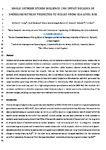Single extreme storm sequence can offset decades of shoreline retreat projected to result from sea-level rise
| dc.contributor.author | Harley, MD | |
| dc.contributor.author | Masselink, Gerd | |
| dc.contributor.author | Ruiz de Alegría-Arzaburu, A | |
| dc.contributor.author | Valiente, NG | |
| dc.contributor.author | Scott, Tim | |
| dc.date.accessioned | 2022-05-18T09:09:29Z | |
| dc.date.available | 2022-05-18T09:09:29Z | |
| dc.date.issued | 2022-05-12 | |
| dc.identifier.issn | 2662-4435 | |
| dc.identifier.issn | 2662-4435 | |
| dc.identifier.other | 112 | |
| dc.identifier.uri | http://hdl.handle.net/10026.1/19230 | |
| dc.description.abstract |
<jats:title>Abstract</jats:title><jats:p>Extreme storms cause extensive beach-dune erosion and are typically considered to enhance coastal erosion due to sea-level rise. However, extreme storms can also have a positive contribution to the nearshore sediment budget by exchanging sediment between the lower and upper shoreface and/or between adjacent headlands, potentially mitigating some adverse sea-level rise impacts. Here we use three high-resolution morphological datasets of extreme storm-recovery sequences from Australia, the UK and Mexico to quantify the nearshore sediment budget and relate these episodic volume changes to long-term coastal projections. We show that sediment gains over the upper shoreface were large (59–140 m<jats:sup>3</jats:sup>/m) and sufficient to theoretically offset decades of projected shoreline retreat due to sea-level rise, even for a high-end greenhouse gas emissions scenario (SSP5-8.5). We conclude that increased confidence in shoreline projections relies fundamentally on a robust quantitative understanding of the sediment budget, including any major short-term sediment contribution by extreme storms.</jats:p> | |
| dc.format.extent | 112- | |
| dc.language | en | |
| dc.language.iso | en | |
| dc.publisher | Nature Research | |
| dc.subject | 13 Climate Action | |
| dc.title | Single extreme storm sequence can offset decades of shoreline retreat projected to result from sea-level rise | |
| dc.type | journal-article | |
| dc.type | Journal Article | |
| plymouth.author-url | https://www.webofscience.com/api/gateway?GWVersion=2&SrcApp=PARTNER_APP&SrcAuth=LinksAMR&KeyUT=WOS:000803112200002&DestLinkType=FullRecord&DestApp=ALL_WOS&UsrCustomerID=11bb513d99f797142bcfeffcc58ea008 | |
| plymouth.issue | 1 | |
| plymouth.volume | 3 | |
| plymouth.publication-status | Published online | |
| plymouth.journal | Communications Earth & Environment | |
| dc.identifier.doi | 10.1038/s43247-022-00437-2 | |
| plymouth.organisational-group | /Plymouth | |
| plymouth.organisational-group | /Plymouth/Faculty of Science and Engineering | |
| plymouth.organisational-group | /Plymouth/Faculty of Science and Engineering/School of Biological and Marine Sciences | |
| plymouth.organisational-group | /Plymouth/REF 2021 Researchers by UoA | |
| plymouth.organisational-group | /Plymouth/REF 2021 Researchers by UoA/UoA07 Earth Systems and Environmental Sciences | |
| plymouth.organisational-group | /Plymouth/Research Groups | |
| plymouth.organisational-group | /Plymouth/Research Groups/Marine Institute | |
| plymouth.organisational-group | /Plymouth/Users by role | |
| plymouth.organisational-group | /Plymouth/Users by role/Academics | |
| plymouth.organisational-group | /Plymouth/Users by role/Researchers in ResearchFish submission | |
| dcterms.dateAccepted | 2022-04-12 | |
| dc.rights.embargodate | 2022-5-21 | |
| dc.identifier.eissn | 2662-4435 | |
| dc.rights.embargoperiod | Not known | |
| rioxxterms.versionofrecord | 10.1038/s43247-022-00437-2 | |
| rioxxterms.licenseref.uri | http://www.rioxx.net/licenses/all-rights-reserved | |
| rioxxterms.type | Journal Article/Review | |
| plymouth.funder | Impact of sequence of extreme storms during 2013/14 winter on southwest coast of England::NERC | |
| plymouth.funder | Impact of sequence of extreme storms during 2013/14 winter on southwest coast of England::NERC | |
| plymouth.funder | Impact of sequence of extreme storms during 2013/14 winter on southwest coast of England::NERC |


